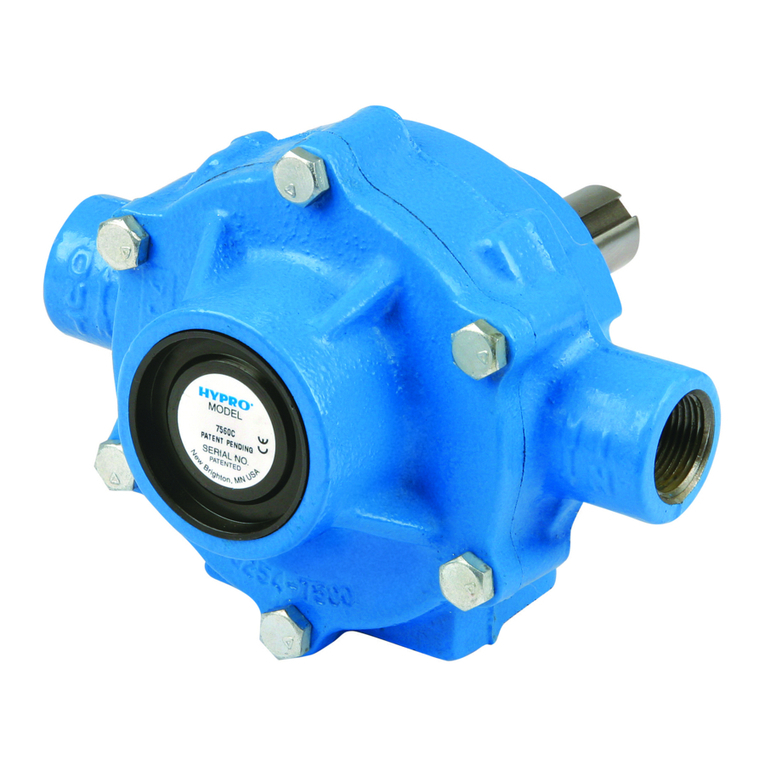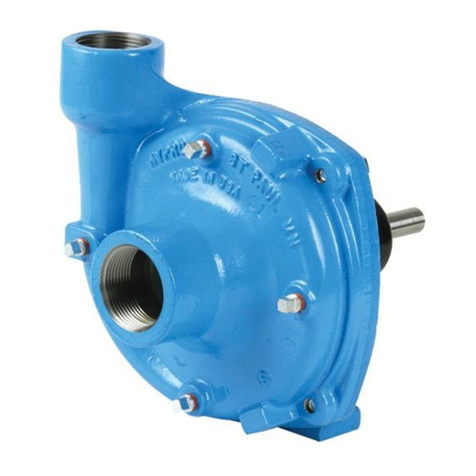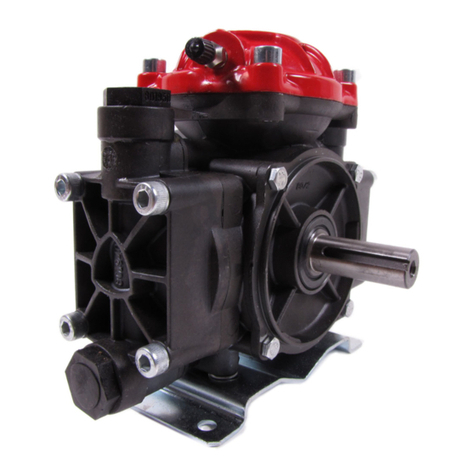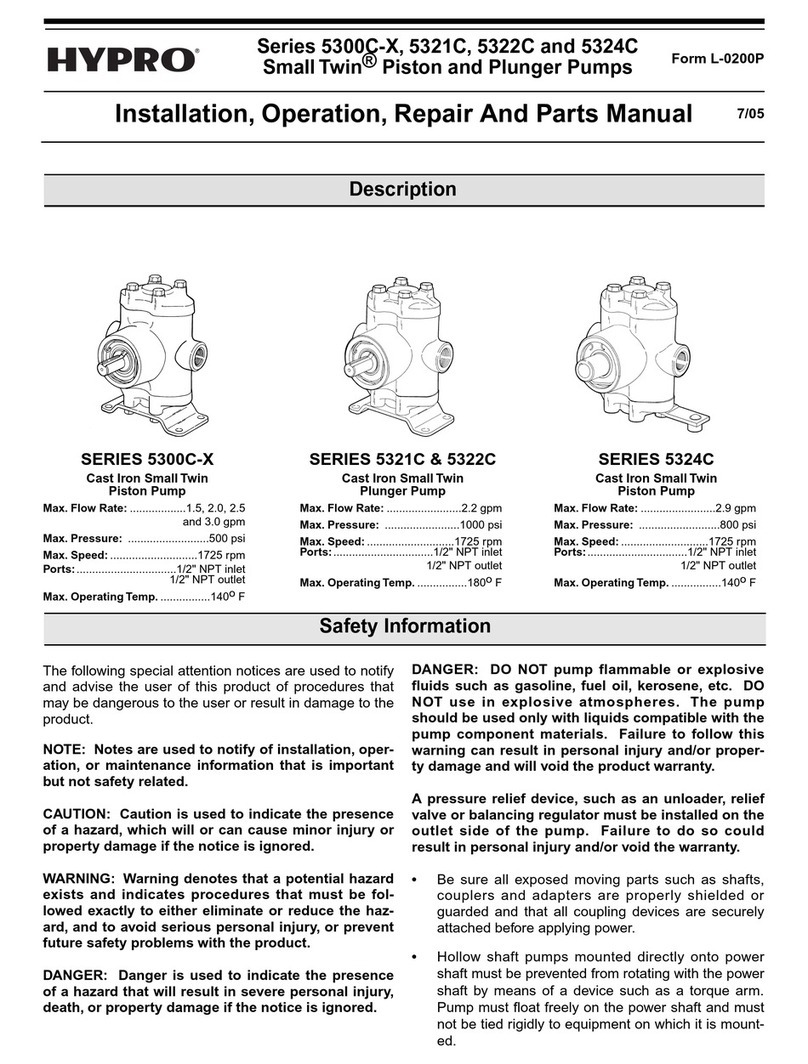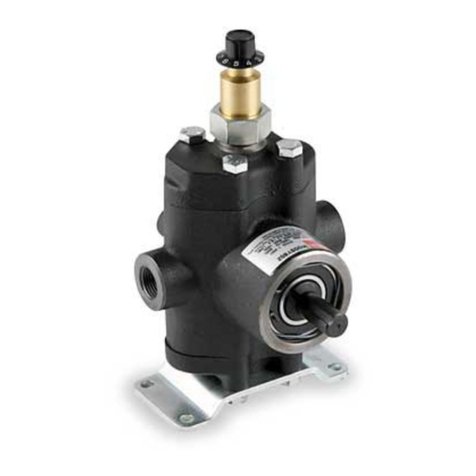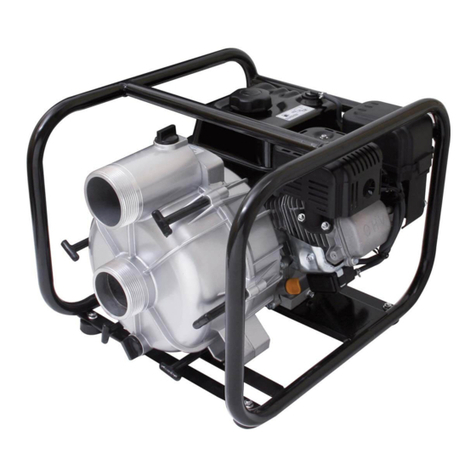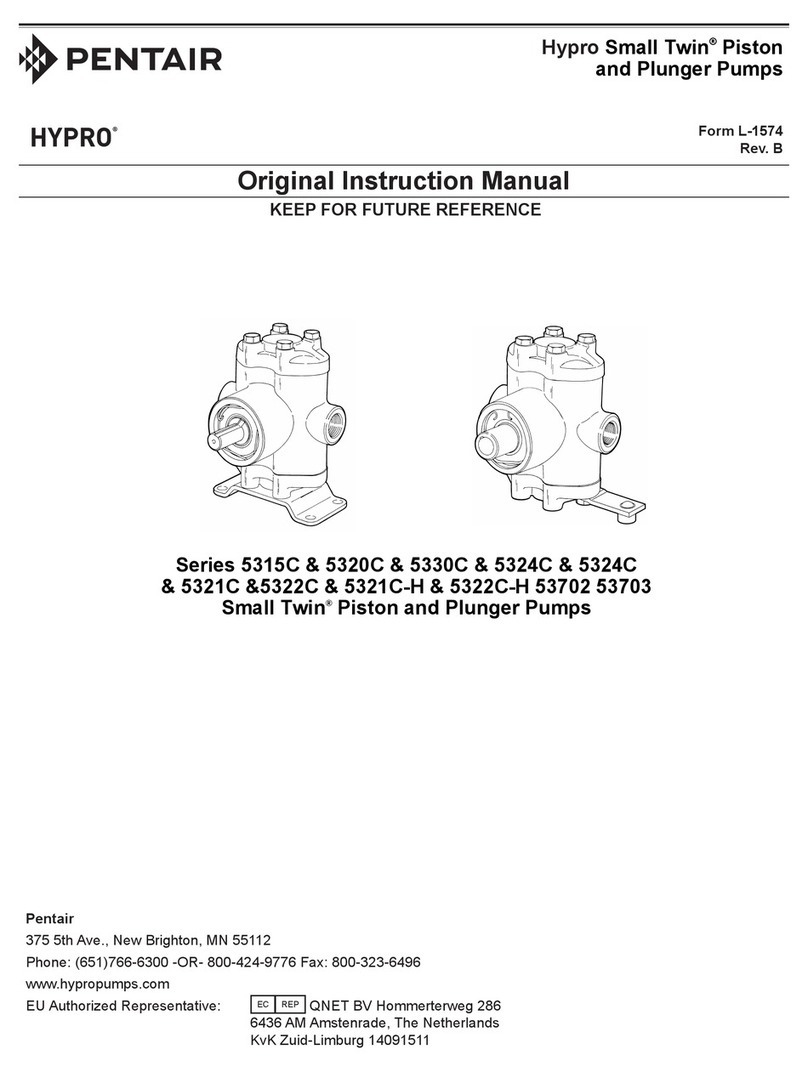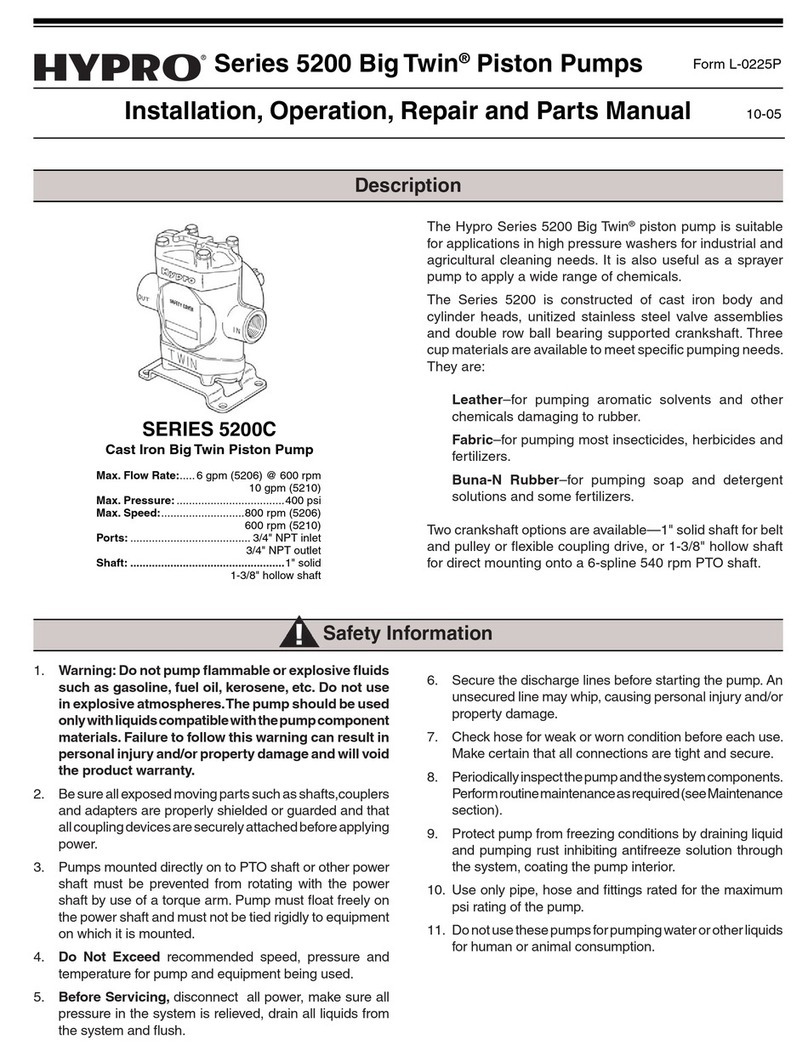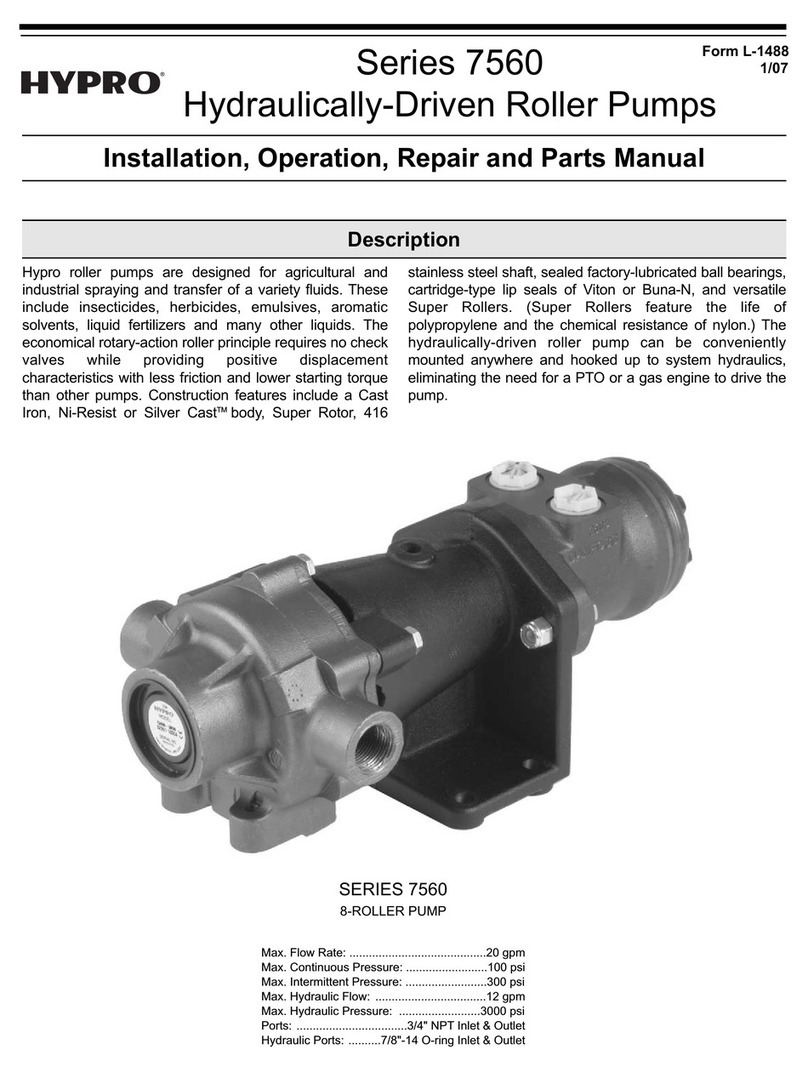
-5-
chamber should be flushed and drained to avoid chemical
corrosion and damage from freezing. Drain by removing the
lower drain plug.
Controlling the Pump Flow
Thebestwaytocontroltheflowisbyincorporatingtwocontrol
valves in a pipe tee immediately after the strainer in the
discharge line. This permits controlling agitation flow
independently of nozzle flow.
In any centrifugal pump, it is the large volume of liquid which
putsloadonthedrive.Useonlytheflowneededtodevelopthe
pressure required at the boom and to maintain adequate
agitation.Hydraulicmotor-driven centrifugalpumpsareeasily
adjusted to the exact flow required, as explained in the
Operating Instructions of this manual.
Hooking Up the Hydraulic Motor to the
Tractor Hydraulic System
HyproSeries9300HMChydraulicmotor-drivenpumpscanbe
mounted on either the tractor or sprayer. When hooking up,
make sure that no dirt or liquid gets into the hydraulic motor.
Keep all hydraulic connections clean. Be sure to connect
the hydraulic motor into the system correctly by putting the
pressurelinetothePressurePortAdapterandreturnlinetothe
Tank Port Adapter. The port adapters on the hydraulic motor
are sized to accommodate 1/2" NPT fittings. For maximum
performance, the hydraulic lines should also be at least 1/2"
[12.7mm]insize.Forlineslongerthan8feet[2.44m]orforthe
HM3Cmodels,hydrauliclinesizeshouldbeatleast3/4"[19.05
mm] in order to reduce heat generation.
Thetank(OUT)portadapterwithabuilt-incheckvalveassembly
willguardagainstreverseoperation —allowing youtoreverse
oilflowtooperateotherequipment.Thisadaptermustnotbe
removed. On HM2C and HM4C model pumps, the pressure
(IN)portadapterisatwo-pieceassemblyconsistingofanopen
(unrestricted)adapterwiththreeorificespackedloose with the
pump (See the Operations Section).
WhenusingtheHM2CorHM4Cunitonanyflowcompensated
(loadsensing)closed center system, or anysmall open center
systemwithamaximumflowof8gpm[30.28lpm]forHM2Cor
10 gpm [37.85 lpm] for HM4C, the metering orifice should be
removed from the pressure port adapter. When using these
units on flow compensated systems, connect to the motor
priority circuit if your tractor has one.
Standardspoolvalves,whicharefoundon all tractor hydraulic
systems,cancausepotentiallydamaginghighpeakpressures
in the hydraulic system when closed, because of abrupt shut-
offofoilflowinboththesupplyandreturnlines. Whenshutting
offthepump,movetheselectortotheFLOATpositiontoallow
the centrifugal pump to come to a stop gradually.
Operation
Open Center Systems—All Models
Adjusting Centrifugal Pump Output
HM1C and HM3C motors have a bypass screw set 1-1/2
turns from fully closed at the factory. HM2C and HM4C
have the bypass screw fully closed from the factory.
1. Open the bypass adjustment screw 2-1/2 turns from fully
closed. Turn the bypass screw in to achieve the flow for
the desired gpm and psi.
2. Startthetractor. Leavethedirectionalvalveintheneutral
position and allow hydraulic oil to circulate for approxi-
mately 10 to 15 minutes or until adequately warmed.
4. Primethecentrifugal pumpwithall valves open (See the
Installation Instructions and System Configuration Dia-
gram).
5. Close the agitation line valve and keep the control valve
and the boom shut-off valve open. Note the spray
pressure.
7. Open the agitation line valve until you have desired
circulation in the tank. Recheck the spray pressure. If it
is too low, close down the agitation line valve until the
desired spray pressure is reached. If the spray pressure
is too high, throttle the centrifugal pump by closing down
the control valve.
Closed Center (Pressure Compensated) —
HM2C and HM4C models only
On a pressure compensated system the amount of oil that is
allowed to flow through the hydraulic motor is regulated by a
metering orifice in the pressure port adapter. Three different
sizesof orifices are supplied with the HM2C and HM4C model
pumps to allow flexibility in the flow required for individual
sprayer needs.
The smaller the orifice the less hydraulic oil goes through the
motor,sothepumpwillrunslowerandtheflowofliquidpumped
andthespraypressurewillalsobeless. Asthehydraulicoilflow
is increased (by installing a larger orifice), the amount of liquid
being pumped and the spray pressure is also increased.
Installing and Removing Metering Orifice
1. Shut off the hydraulic system.
2. Disconnect the line to the pressure port of the hydraulic
motor.
3. Remove the adapter from the motor using a 1-1/16''
wrench.
